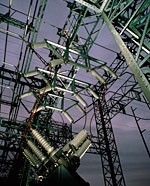REASONS FOR HIGH RATES
Electric rates may be poised to soar this year in several states as rate caps expire and consumers are hit with soaring electric bills - just as the summer heat kicks in. As part of the legacy of deregulation, rate caps were imposed on utilities as a means of providing a transition to deregulated power markets in states which chose to restructure their utility industry.The end result was that utilities either sold off their generation plants or spun them off as separate, unregulated companies, which now supply power at the market price.
The recent run up in fuel prices for oil and natural gas means that the cost of buying power in the market, along with the form in which power is purchased (uniform price auctions in which all sellers are paid the market clearing price) means the rates may climb by as much as 40-80 percent for some utility customers. The affected states include Michigan, Maryland, Connecticut, Delaware, Illinois, and parts of other Northeastern areas.

CONSUMERS TAKE ACTION
Price increases in this range may spur consumers to increase their efforts to save energy through the purchase of energy-efficient equipment and products, if they are not mitigated by state legislative or regulatory action.While there is no direct statistical evidence between electric rate increases and purchases of energy-efficient products, there is some anecdotal evidence, which indicates that consumers respond to such hikes by taking measures to save energy.
The best example is in California, which experienced similar sharp increases in 2000-01. The California energy crisis began in San Diego when SDG&E, the first utility in that state to be freed from price caps, passed on its higher costs of electricity to customers who saw their rates double in short order. This produced a backlash against deregulation but also began the push for energy conservation and efficiency. California now has the most progressive energy-efficiency program in the nation.
While customers initially curtailed their energy use to save money, they also began to purchase more energy-efficient equipment to maintain savings in the longer run. Studies indicate that 50 percent of the initial energy savings statewide has been retained to date. An analysis by Lawrence Berkeley National Laboratory estimates that about 1,000 MW of the demand reductions were hard-wired through energy efficiency investments.

MEASURES TO FIGHT BACK
However, the California experience indicates that more than just high rates are needed to capture and retain long-term energy savings through energy efficiency. The state has developed a comprehensive program designed to reduce power demand and promote investments in energy-efficient technology. Among the steps taken:
This last step may be the most crucial because it provides the means to develop and implement strategies to improve energy efficiency, including the process of introducing new energy efficient technologies into the marketplace, gaining significant market penetration, and integrating the technologies into everyday life.
The California Public Utilities Commission (PUC) oversees the investor-owned utilities' energy efficiency programs, which include rebates for the purchase of lighting, air conditioners, HVAC systems, motors, and appliances. The utilities use an extensive network of energy-efficiency professionals, consultants, and contractors with experience at delivering new technologies into the marketplace to implement many of the efficiency programs.
The bottom line for contractors is that the coming increases in electricity rates can be an opportunity to increase sales and services. However, such increases need to be seen as something other than just a temporary spike and more than just the increases themselves are necessary to spur investments in energy efficiency.
Contractors should consider working through their state associations to ensure that state officials and legislators are prepared to follow California's example in creating and properly funding mechanisms designed to promote energy efficiency investments and capture long-term energy savings.
Do have questions about legislative and regulatory developments regarding energy policy, energy efficiency, electricity, fair competition, etc? Send questions to johnhall@achrnews.com.
Tony Ponticelli is a practicing attorney in Washington, D.C. He has also served as director of government relations for the National Asphalt Pavement Association, executive secretary of the National Construction Industry Council, chief of staff for a trio of nonprofit organizations established to implement the findings of the Grace Commission, and executive director of the National Alliance for Fair Competition.
Publication date: 05/22/2006

Report Abusive Comment